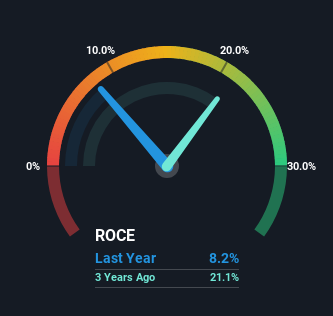Here's What's Concerning About Adani Wilmar's (NSE:AWL) Returns On Capital

There are a few key trends to look for if we want to identify the next multi-bagger. Ideally, a business will show two trends; firstly a growing return on capital employed (ROCE) and secondly, an increasing amount of capital employed. Basically this means that a company has profitable initiatives that it can continue to reinvest in, which is a trait of a compounding machine. Having said that, from a first glance at Adani Wilmar (NSE:AWL) we aren't jumping out of our chairs at how returns are trending, but let's have a deeper look.
What Is Return On Capital Employed (ROCE)?
For those that aren't sure what ROCE is, it measures the amount of pre-tax profits a company can generate from the capital employed in its business. Analysts use this formula to calculate it for Adani Wilmar:
Return on Capital Employed = Earnings Before Interest and Tax (EBIT) ÷ (Total Assets - Current Liabilities)
0.082 = ₹7.7b ÷ (₹198b - ₹104b) (Based on the trailing twelve months to March 2024).
Therefore, Adani Wilmar has an ROCE of 8.2%. In absolute terms, that's a low return and it also under-performs the Food industry average of 14%.
See our latest analysis for Adani Wilmar

In the above chart we have measured Adani Wilmar's prior ROCE against its prior performance, but the future is arguably more important. If you'd like to see what analysts are forecasting going forward, you should check out our free analyst report for Adani Wilmar .
What Does the ROCE Trend For Adani Wilmar Tell Us?
On the surface, the trend of ROCE at Adani Wilmar doesn't inspire confidence. To be more specific, ROCE has fallen from 28% over the last five years. And considering revenue has dropped while employing more capital, we'd be cautious. If this were to continue, you might be looking at a company that is trying to reinvest for growth but is actually losing market share since sales haven't increased.
On a related note, Adani Wilmar has decreased its current liabilities to 53% of total assets. So we could link some of this to the decrease in ROCE. Effectively this means their suppliers or short-term creditors are funding less of the business, which reduces some elements of risk. Some would claim this reduces the business' efficiency at generating ROCE since it is now funding more of the operations with its own money. Either way, they're still at a pretty high level, so we'd like to see them fall further if possible.
The Bottom Line On Adani Wilmar's ROCE
In summary, we're somewhat concerned by Adani Wilmar's diminishing returns on increasing amounts of capital. Long term shareholders who've owned the stock over the last year have experienced a 19% depreciation in their investment, so it appears the market might not like these trends either. With underlying trends that aren't great in these areas, we'd consider looking elsewhere.
One more thing, we've spotted 1 warning sign facing Adani Wilmar that you might find interesting.
While Adani Wilmar may not currently earn the highest returns, we've compiled a list of companies that currently earn more than 25% return on equity. Check out this free list here.
New: Manage All Your Stock Portfolios in One Place
We've created the ultimate portfolio companion for stock investors, and it's free.
• Connect an unlimited number of Portfolios and see your total in one currency
• Be alerted to new Warning Signs or Risks via email or mobile
• Track the Fair Value of your stocks
Have feedback on this article? Concerned about the content? Get in touch with us directly. Alternatively, email editorial-team (at) simplywallst.com.
This article by Simply Wall St is general in nature. We provide commentary based on historical data and analyst forecasts only using an unbiased methodology and our articles are not intended to be financial advice. It does not constitute a recommendation to buy or sell any stock, and does not take account of your objectives, or your financial situation. We aim to bring you long-term focused analysis driven by fundamental data. Note that our analysis may not factor in the latest price-sensitive company announcements or qualitative material. Simply Wall St has no position in any stocks mentioned.
About NSEI:AWL
AWL Agri Business
A fast-moving consumer goods food company, provides kitchen commodities in India.
Solid track record with excellent balance sheet.
Market Insights
Community Narratives



